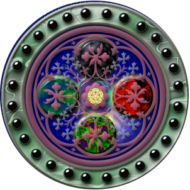Magic Bullet #1
Historically, and particularly in the 19th. Century, a medical cure in the form of a pill or injection has been referred to as a “Magick Bullet.” This usage derives from an imperfect knowledge of the mechanism by which the curative worked; in fact, often an incomplete knowledge of the nature of the illness, itself. Thus, the Magick Bullet was somehow imbued with an intelligence that allowed it to travel the courseways of the body and, on arriving at the locus of injury, there deliver its lethal charge against the unseen, and even, unexpected, contagion.
Magic Bullet #2
Yet another, more recent, derivation of the term Magic Bullet, comes from Communication Theory. The Magic Bullet school held sway in the 1960s and early 1970s as the predominating model used to describe mass communication. This model holds that communications, in the form of messages, are disseminated outward from a point of origin, that they travel for some period of time as if suspended in a “medium.” When a suitable receiver is available — a human ear, for example — the messages find a target to strike, and thereby complete the act of communicating: A Magic Bullet, fired blindly, that somehow manages to find its intended target.
The Magic Bullet theory of Communications is a One-Way only model, consistent with the era of its currency. In the 1960s and 1970s, interactive media had yet to emerge from the laboratory. Instead, the dominant organs for mass communication were Television, Radio, Movies and Print. Moreover, most of the advertising (messages) of the time was produced and delivered without the benefit of market research. Thus, the bullets went largely uncalibrated.
As focus group testing, questionnaires, and other methods of marketing effectiveness testing came into widespread use; and as more interactive forms of media (e.g.: internet, radio call-in shows, etc.) became available, the Magic Bullet theory of Communication was replaced by a variety of other, more instrumental models.
Magic Bullet #3
In 1984, Michael J. Norris, of Philadelphia, began publication of a small-format magazine from the Replica IV repro-copy shop where he was manager. This was the first edition of the “Magic Bullet.” The name was chosen for its evocation of the two meanings previously described. The Magic Bullet would be a one-way communication; produced at its publishers’ expense, and distributed to an unknown audience; there to find, wherever it might, a receptive heart. Also, being an art and poetry review, the intention was for the contents of the magazine to have some curative, restorative powers, hence the Magick Bullet of the last century.
The Magic Bullet magazine was a discrete element in a much larger movement of the time. In America and throughout the world, people were learning to use the photocopy process as a means of self-publication. The late 1970s saw the flowering of the “Mail Art” movement as an alternative to the structures and judgements of an Art establishment that regarded cheaply produced reproductions as, if not an actual threat, then certainly a counter-aesthetic aberration. By using the public mail as a distribution medium, mail-artists were able to reach out directly to their publics, often reaching a much wider audience than mere gallery exhibits ever could.
The “xero-mag” — of which the Magic Bullet was an instance — was the immediate precursor to the incipient field of desktop publishing. It’s important to remember, here, that the Magic Bullet, and most Mail Art in general, was not typeset. Text was either produced on typewriters, or had to be hand set using one of a variety of rub-on methods. The computer type “font” had yet to appear.
Magic Bullet Press
Mr. Norris published three issues of the Magic Bullet in 1984. In the following year, Gary L. Gehman and A. Craig Dickinson acquired the plant and assets of the former Limper and McCartney letterpress and hot-type facility in North Philadelphia, bordering Kensington. The pair had been printers in the Temple University duplications department and both had been early contributors to the original Magic Bullet magazine.
Mr. Dickinson had recently acquired one of the new Apple Macintosh computers for home use and began using it to produce graphic elements for the new Magic Bullet Press. To this, Mr. Gehman soon added colorful output from the even newer Commodore Amiga computer, and the results started to take the Magic Bullet magazine in whole new directions. During this period, as the publication moved from xerographic process to photo-offset, the Magic Bullet Press paced, maybe even leading, the wider field of DIY computer-assisted publishing. The very first issue of Magic Bullet from Magic Bullet Press (Jan 1, 1986) used mechanical color separation techniques for its cover.
In 1986, Magic Bullet Press commissioned poet and author Remington Murphy to compile stories from Magic Bullet contributors to be published in a book-length issue. This was to be the Magic Bullet Science Fiction Anthology for 1987. The finished book, 162 pages, contained poetry, short-stories, comic strips and photographs. It was tyepset, printed, collated and perfect-bound, all by hand, by Magic Bullet, chiefly Mr. Dickinson and friends.
The Magic Bullet Press disbanded in 1988. Problems of distribution and lack of profitability made it impossible to continue publishing magazines out of pocket. The final edition of Magic Bullet includes the appeal: “Magic Bullet, a lesson in deficit spending, is published six times a year. Send a SASE w/39 cents postage for your free copy.”
